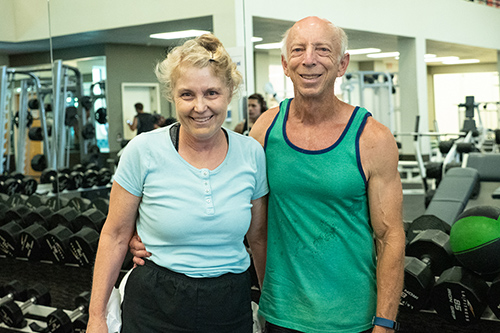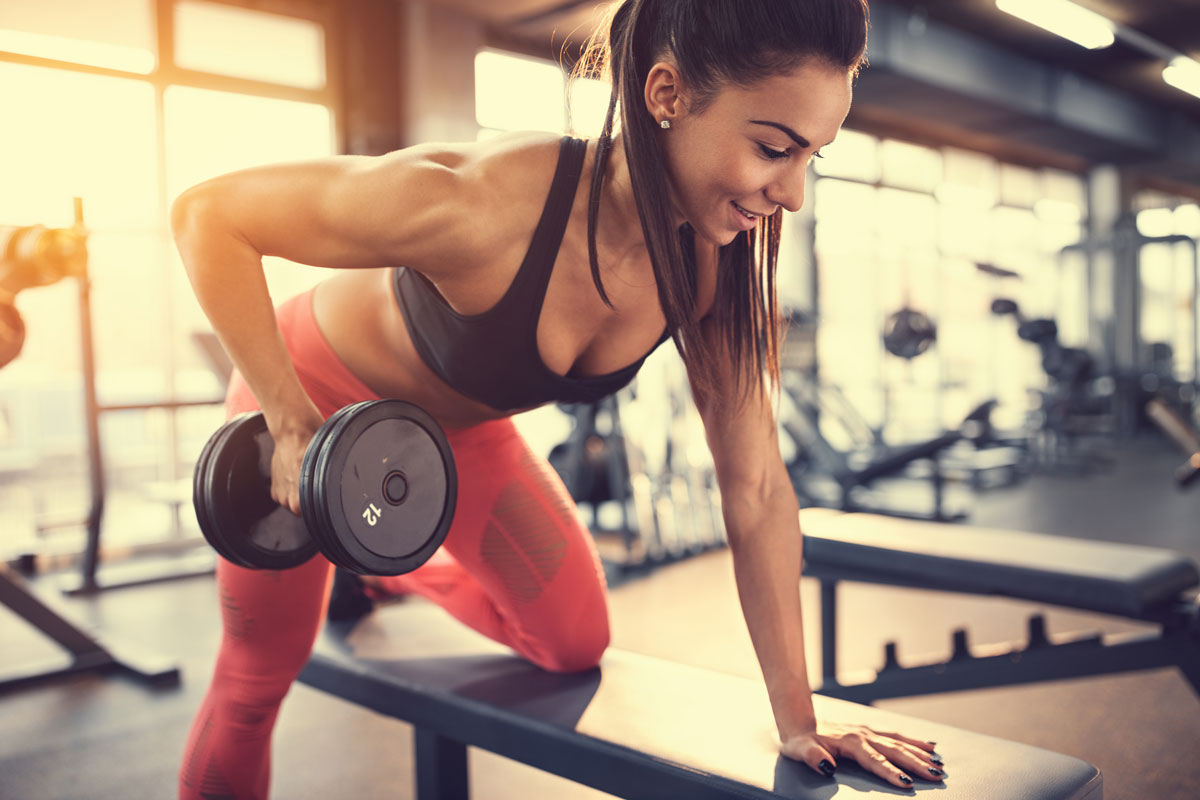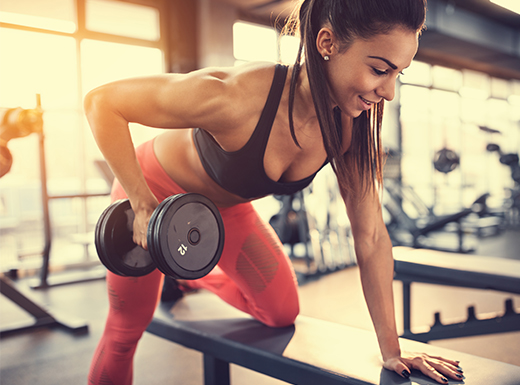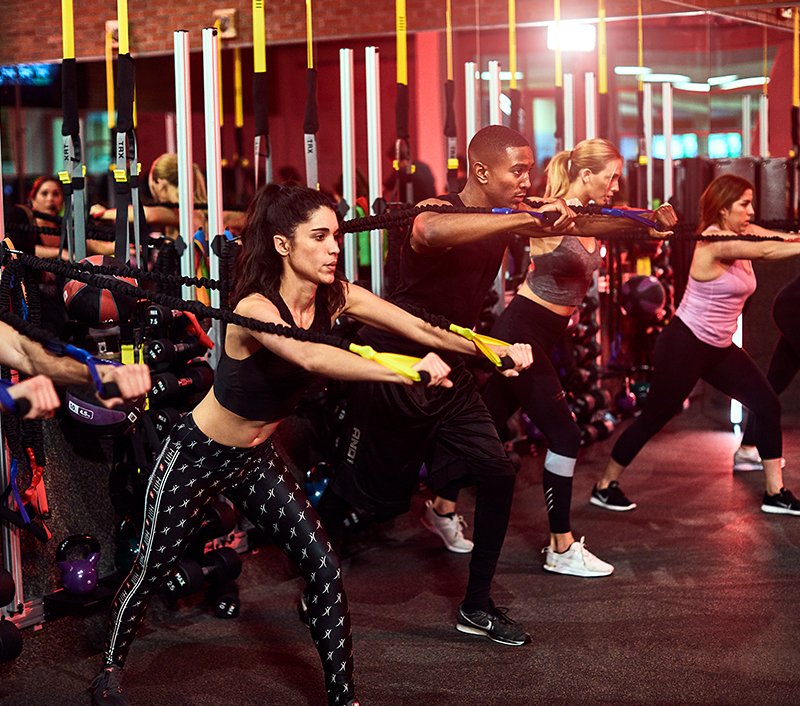Member Spotlight | Fountain of Youth
Paul and Karen share how they have maintained a lifelong commitment to living an active lifestyle and break down their weekly gym routine.

Evidence Based
Dancing is not just a form of expression, not just reserved for the artistically inclined, and not as difficult to start as you might think. We invite you to challenge your thoughts of “I can’t do it” or “it’s not for me,” so you too can enjoy the benefits of this versatile form of exercise.
Dancing extends across the boundaries of physical movement. You can dance for your fitness, for physical therapy, for cognitive therapy, to enjoy a social activity, or to take time alone. Today we will focus on the physical and cognitive benefits of dancing.
If you already have the dance bug and just want to dive in, browse our website to learn about our many dance style Group Fitness Classes. We host a variety of classes like Belly Dancing, Cardio Jam, Hip Hop, Latin Heat, Zumba, and Yogabeat. Be sure to search by zip code to learn which classes are available at the LA Fitness clubs closest to you.
Without further ado, let’s take a look at some of the physical and cognitive benefits of dancing!


Every move you make as you dance is deliberate; there’s no laziness here. You need to engage your legs and core to keep your body stable, and your back and shoulders to carry your posture. As your muscles learn to move your weight in new ways as you step, lift, drag, kick, and flick to the beat, they will get stronger. This functional strengthening is what promotes better balance and overall posture.1
You may still be thinking of dance as just another cardio type exercise, and it can be excellent for your heart, but did you know dancing also benefits your bone strength? Think about it this way: your muscles are attached to your bones; and when you strengthen your muscles, it’s like you’re reinforcing the bones.
One article on The Health Benefits of Dance states that “the side-to-side movements of most dance steps help to strengthen the weight-bearing bones such as the femur, tibia, and fibula.”2 That sounds a lot like the steps you would see in Latin dances like the Cha-Cha-Cha, Merengue, or Salsa. If you’re looking to add some focus on your lower body, our Latin Heat or Zumba classes might be just what you’re looking for!

When it comes to heart health, “dance can be as beneficial as jogging around a track, biking, swimming, or running on the treadmill.”2 We know that cardio is excellent for exercising your heart, and that when you exercise your heart you benefit your whole body. One study confirmed that Zumba participants who had high blood pressure, effectively and significantly lowered their blood pressure after only 2 months of Zumba!3
Not only are you benefiting your heart and improving your blood pressure, you are burning calories with every step. Burning calories can help you shed the pounds, especially if you are also mindful of your nutrition.
Depending on the level of intensity, your range of motion, your physical condition, and more, “the continuous motion of dance… [will allow you to] burn anywhere from 200 to 500 calories during a 1-hr session.”2

Because dancing is a total body exercise, you can expect some total body toning. “Some dance forms,” like Belly Dancing and Hip Hop, “have repetitive movements such as hip drips, figure eights, circles, and shimmies, which can put the lower back and hip joints and ligaments through full range of motion that increases muscle tone and improves posture.”2 Strengthening these particular parts of your body can aid in the prevention of lower back problems.2
Now that you know about the physical benefits, let’s get into how great dancing is for your brain.


Neuroplasticity is your brain’s ability to form and optimize synaptic connections. This basically means that it is capable of growing, adapting, and changing. This is a very good thing because it means your brain can adapt to new situations and recover from old ones.
Consider that most dancing requires you to learn a specific series of movements in a specific order for a specific amount of time. This prompts your brain to develop new neural pathways to allow this complex learning to take place.
In fact, research has found that expert dancers have structural differences in their sensorimotor networks and in physical parts of the brain like the hippocampus (the part of brain responsible for emotion, memory, and your autonomic nervous system).1
In general, physical exercise, especially aerobic exercise, has been shown to decrease the risk for neurological disorders, especially for cognitive decline, dementia and Alzheimer’s.1 To a lesser extent, there is also evidence to support that physical exercise can reduce your risk for Parkinson’s Disease and Strokes.1,4,5
Dancing, however, has more benefits for the brain than repetitive physical exercise.6 A study on neuroplasticity in older adults found that, because dance requires constant cognitive and motor learning, it can counteract age-related cognitive decline.4 When it comes to brain health and function, the complexity of dance beats plain physical exercise.

Never get called a clutz again. Dancing can improve your coordination because it, itself, requires a great deal of coordination. Have you ever tried to rub your belly with one hand and tap the top of your head with the other hand? It takes a certain amount of concentration, doesn’t it?
With dancing, not only do you need to coordinate between the different limbs of your body, but you must do the same between other dancers on the floor, and hone-in on your timing and spatial awareness.7
Coordination exercises have actually been shown to improve attention and concentration, even more so than simple aerobic exercises.1
We know there’s a lot of research here so let us leave you with some simple takeaways:
For more on brain health, read our registered dietitian’s article on These 7 Foods That Promote Brain Health. Or, check out her article on The 8 Best Foods for Your Heart. To access our monthly blog post highlights, subscribe to our newsletter today!

“If there is a fountain of youth, there’s a good chance it can be found (after a certain amount of sweating) within the walls of the gym.”
Paul and Karen have been members of LA Fitness for over 25 years and have lived an active lifestyle for even longer than that. We reached out to this inspiring couple to hear first-hand how they made fitness a priority and managed to maintain it as a lifelong standard.
Well before these two even met, they each enjoyed activities like swimming, jogging, cross-country running, and long bike rides in the city and by the river.
These weren’t any ordinary activities, however. Karen started swimming at age 6 and eventually joined her high school swim team, while Paul’s bike rides would typically be around 20 miles long!
In 1978, Paul was hit by a car on his bike ride home from work. He had his eyes set on a 10K that was merely a month from then, and though he had stopped running due to a cross country injury 7 years prior, he promised himself he would recover from the accident in order to run the 10K. He has been running ever since.

“Karen and I met at UCR where I had noticed her swimming and found out about a team triathlon coming up,” explains Paul. “She said she’d do the one-mile ocean swim in Baja on our team…We won that triathlon in 1982. Ever since, we have inspired each other to keep going and shared and traded our fitness ideas and commitments.”
Winning the triathlon was clearly only the beginning of a lifetime of setting and hitting fitness goals together, but it was never just about training for the races. Paul reminds us that together, they “have looked at fitness as a very important part of life in the very long run.”
“Probably the most unusual thing about both of us,” he says, “is that we both value health and fitness very highly and have for a long time, long enough ago that we can’t say when this commitment began.”
Over the years, Karen adopted some of Paul’s fitness routines, like lifting weights, and he adopted some of hers, like swimming. “In 1994, Karen had an opportunity to join LA Fitness (in Upland, CA) and she got me to join then too,” says Paul. “There was no LA Fitness near our home (in San Diego County) for another 8 years, but we used the Upland gym whenever possible, in hopes that someday one would open closer to us.”
To put this information into perspective, consider this very rough estimate: San Diego is about 116 miles from Upland. This means that in moderate California traffic, that drive can take over 2 hours!
To keep his exercise routine consistent, Paul continued to work out at UC Riverside. In the ‘70s, he took a weight class that utilized an old Universal all-in-one station. “My current routine may still have echoes of those early days,” he says.
“Later, when I had access to free weights and separate weight stations, I observed others and developed a routine that focused on my weaknesses and mixed up lifts so different muscle groups wouldn’t get overused. I added or modified lifts and the order I did things to get the most out of my time.”
When Karen graduated, she found a job and utilized her lunch times to swim or run. “Later, she attended various gyms (that are no longer in existence) near home when she had the chance. She has expanded and adjusted her weight program as well, finding a routine that fits her best.”

“Once our local LA Fitness opened in Vista, we were in heaven. Our formerly limited routine could be infinitely enlarged because of all the machines and range of weights and cardio equipment available. Karen found much more suitable machines for her and continues to add or adjust her program. I have done the same.”
At this point, Paul and Karen were able to add a core weight and a core cardio routine to their gym sessions. They complete their weight circuits twice a week and do various cardio workouts 4 days a week. “We don’t do cardio and weights on the same day,” clarifies Paul, because that would mean “we would have to reduce the intensity of both if we had to do both in one session.”
“Here is where we might be different than most people,” says Paul. “We like cardio and we push hard. We attend one spin class each week and run once a week. Karen likes the different elliptical machines and will use the pool, while I will go between the stationary bike, rowing machine, and elliptical machines.”
For the most part, Paul and Karen work out 6 times a week and have been doing so for years. Still, “we look forward to our trips to the gym as much as ever.”
As regular gym-goers, Paul and Karen have come to know many people at the gym who they’ve become close friends with over the years. “Even the maintenance guy at our gym often seeks us out to ask how the machines are doing,” Paul says.
“Having been doing fitness for so long, age has become a slight modifier as well. Neither of us can run or swim as fast as we could in our invincible 20s, but surprisingly we can do just about everything we ever have, with little change over time. We still challenge ourselves and will increase a weight every now and then. Karen and I do bench press together, and have fun encouraging each other (and now our sons, who also are members).”
If there was one thing these two enjoy most about working out, “it would probably be the satisfaction of knowing that we are doing the most important thing we can do to maintain a high level of health. We are evading a lot of problems people acquire as they get older mainly because we are serious about staying as fit as we can. If there is a fountain of youth, there’s a good chance it can be found (after a certain amount of sweating) within the walls of the gym.”
Perhaps a great advantage is in the fact that they share the same love for fitness and healthy living. “We have met a lot of people at the gym who wish their significant other was there with them,” explains Paul. “Without that encouragement it must be a lot harder to maintain what should be a lifelong commitment. We both willingly set aside the time to work out and understand how important it is for both of us.”
In addition to working out together, they also work out alone. They make sure to do what they individually need to do in the gym and will help each other on certain equipment throughout their exercise.
“If there could only be one piece of advice, it would be: Make fitness an essential part of life.
The unsaid corollaries of that statement would be ‘Don’t quit, ever!’ and ‘Do a lot of cardio, and a lot of sweating.’”
It may be easier said than done, but Paul and Karen have proven that despite injury, regardless of age, and with the support of like-minded support systems, maintaining an active lifestyle is possible and enjoyable! You just need to find what works for you and keep driving yourself forward.
Do you have an inspirational story you’d like to share with us? Email us at blog@lafitness.com for a chance to be featured in an upcoming post!
For length and clarity, minor edits – none of which alter the original or intended meaning – have been made to the quotes provided.
Paul and Karen share how they have maintained a lifelong commitment to living an active lifestyle and break down their weekly gym routine.
Meet Matt M., an LA Fitness employee, who never stepped foot into a gym until recently. This is the beginning of his story, and quite the story it is.
If you want something bad enough, you have to put in the time and effort. In our latest Member Spotlight, Janelle G. shares how she finally managed to lose the weight that she struggled with her entire life.


Question:
Hello, I’m a male, age 37, my height is 5’11”, and I weigh 263 pounds. I’ve been sticking to a 1,400-calorie plan pretty strictly with a calorie counter app and weight scale, and I have lost about 32 pounds. This past month I’ve noticed that the weight loss has slowed significantly and is fluctuating much more than the months prior.
Now that I’m 32 pounds lighter, how can I calculate a new BMR?
Along with the weight loss, I am significantly more active as well. I do work an office job 9 hours/day, 5 days a week. But I also get to the gym 6 days/week and do somewhere between 30-45 minutes of strength training and 30-45 minutes of cardio, as well as 6 personal training sessions a month. I usually finish my eating for the day around 8/8:30 pm, and fast until 10 am the next day, sometimes waiting until lunch at 12:30 pm.
I’m kind of lost on if I should keep going with what I’ve been doing, or adjust my nutrition routine? And if I should adjust it, what’s the best route to go? Keep fasting? Bump up my calories? More protein? Thanks for your help.
– Steven M.

You’re doing great on your own, Steven! Weight reduction exceeding 2 pounds per week is not considered solely fat loss but also lean and water weight. If your rate of loss has slowed after a couple of months, that’s expected. You don’t really reach a “plateau” until you’ve not lost for several weeks. As you gain muscle the scale may not reflect any change. How has your body composition changed? You’ll want to look at both your body fat % and circumference measurements to get a sense of true progress.
Based on your stated anthropometric measures and physical activity, I estimate your energy needs to be about 2350 calories for weight loss; a fair jump from your 1,400 per day limit. Rather than use basal metabolic rate, I’d recommend using resting metabolic rate (RMR) which includes bodily functions as your base level of calories to consume. That figure is closer to 2100 calories per day, based on Mifflin-St. Jeor equation. Still a bit greater than your current intake.
To answer your last questions, I’d recommend initially bumping up your calories to 1,600/day by adding nutrient-rich whole foods (think veggie salad, beans and avocado), continue your routine and track your changes for the next month before deciding on next course of action.
– Debbie J., MS, RD
This article should not replace any exercise program or restrictions, any dietary supplements or restrictions, or any other medical recommendations from your primary care physician. Before starting any exercise program or diet, make sure it is approved by your doctor.
Some questions have been edited for length and/or clarity.
 Have a nutrition question? Our registered dietitian is ready to help!
Have a nutrition question? Our registered dietitian is ready to help!
Email nutrition@lafitness.com or submit your question below and it may be featured in an upcoming article!
Debunking fitness myths surrounding the ideas of muscle building and fat burning.
Is it OK to eat before a morning swim or is it better for the body to workout in a fasted state? Debbie James, RDN, weighs in and shares the benefits of fasted cardio.
These quick tips may change your life

When a championship or trophy is on the line, every opportunity for an athlete to practice makes a difference. The same is true of exercise sessions in preparation toward achieving a physical goal. Too many people run through their workout just to check it off as done instead of utilizing the workout to its full potential. Instead, treat the session like elite athletes do – as a rehearsal for the biggest physical performance they’ll do that season.
“Make each day your masterpiece“ – John Wooden
Effort, drive and determination are often attributes associated with athletes pushing through tough practices. Hence, the “no pain, no gain” exercise motto. But enthusiasm, purpose and intense focus may be just as important for progress1. For successful workouts, having a positive attitude, a goal for that session and focused attention are key.

Three Key Factors You Need


01.
Enthusiasm is a cornerstone of the late basketball coach John Wooden’s famous Pyramid of Success2. He described enthusiasm as that “which infuses hard work with inspired power.” Without the passion and joy for what you are doing, you can easily slip into worker bee mode to get your workout over with. Enthusiasm is a spark that ignites the willingness to proceed. It’s characterized by feelings of excitement and high levels of enjoyment3. If you’re not loving what you are doing, find another way of doing it or switch up your workouts.

02.
Purpose Personal meaning powers action – it’s caring enough about what you’re doing. Finding your purpose goes beyond the outcome you seek, but the “why” you are striving for it to begin with. Putting your personal values as top priority can lead you to perform better4. Nothing else can take precedent during your exercise session. Purpose is supported by the belief that you are responsible for your own success. Having an identified purpose helps you overcome pressure and stress and to bounce back from losses.
“The successful warrior is the average man, with laser-like focus.“ – Bruce Lee

03.
Intense Focus With digital distractions it’s easy for one’s mind to wander off course. Sport psychologists say that being in the moment is crucial for effective practice5. Worry about what you can execute in the present instead of dwelling on the past. Pay greater attention to the action you’re doing instead of smartphone alerts, the environment around you or thoughts of the outcome. Whereas you might get away with reading while doing some low-intensity steady-state cardio, strength-training requires focus6.
Definition: Practice is the repetition of an action with the goal of improvement.
All that is not to say that the treadmill setting or weights have to be different or more than your last workout. On the contrary, repetition with good form allows you to improve on quantity or speed later. The TED-Ed video entitled “How to practice effectively…for just about anything” by Annie Bosler and Don Greene has an expanded explanation for the reasons why repeated practice works — one of them is neural processing. You actually create the neural pathway to do an action unconsciously by repeating it until the action becomes reflexive.
Treating your workout like a household chore to get done will likely make the session, well, …a chore. Consider each exercise session a rehearsal – a chance to fix mistakes and move forward toward a winning performance, even if you are the only audience. Embrace what you’re doing, make your purpose a priority and narrow your attention to your present action.
References


Most of us have been told a lie in the gym at some point. The real question is, did you believe it? If someone has helped you or given you tips, did you ever research what they said or did to see if it was true? There’s a chance that it was completely wrong.
We’re going to go over and debunk a handful of myths surrounding the ideas of muscle building and fat burning.
When we exercise moderately, it’s true that more fat can burn compared to carbohydrates. However, this type of training burns fewer total calories and takes significantly longer. High intensity exercises like HIIT (high intensity interval training) can burn more calories in a shorter amount of time and can cause an “after-burn” effect fueled by fat that can last a day or longer. I personally found success with HIIT training. HIIT by LAF is great for those interested in high intensity workouts looking to burn some calories!

“Don’t eat late at night.” “Eat dinner earlier.” “No carbs before bed.” These seem to be some common statements we hear for losing weight and they couldn’t be more inaccurate. Calories are calories and if you eat too many of them you’ll gain weight, regardless of what time it is. According to a , overweight people lost more weight eating carbohydrates at night compared to throughout the day. The late-night eaters had better hormone levels that control satiety and hunger. The Human Growth Hormone (HGH) is a powerful hormone produced by the human body that regulates the amount of body fat you burn and the amount of muscle you build. HGH levels peak while you’re sleeping so if you eat right before bed, your body could utilize those nutrients to build muscle and burn fat at the same time.

What’s going to burn more fat calories in 20 minutes: watching TV, walking, or interval sprinting? If you think it’s TV or walking, you’re wrong. Just because you burn a higher percentage of fat from moderate exercise doesn’t mean you’ll burn as many total fat calories. Interval sprinting burn a less percentage of fat but a much higher total calorie loss, which actually results in more fat calories burned than walking for 20 minutes.
A family member of mine went on a diet a while ago to try and lose weight. She was told to double her protein intake and eat less carbohydrates. She ended up miserable and weighing more than she did before her diet. We’re not saying protein doesn’t build muscle, but there’s a point where protein can hurt compared to help. For every pound of body weight, consuming about Any protein consumption over the 1.25g per pound of bodyweight can get broken down in to amino acids and nitrogen which can either store in your body or excrete your body.
If someone is trying to give you a fitness tip, listen to what they have to say but do your own research and come up with your own opinion. Everybody has a different body and genetic makeup. What works for one person might not work for another. Know what works best for you and own your workouts!
References
Dancing requires your brain to process and coordinate multiple things at once. Find out how having fun can benefit your body and your brain!
Paul and Karen share how they have maintained a lifelong commitment to living an active lifestyle and break down their weekly gym routine.
Debbie James, RDN, helps answer a reader’s question about how to calculate Basal Metabolic Rate and about nutrition adjustments for continued weight loss.
Be the first to know about exclusive
content, deals and promotions